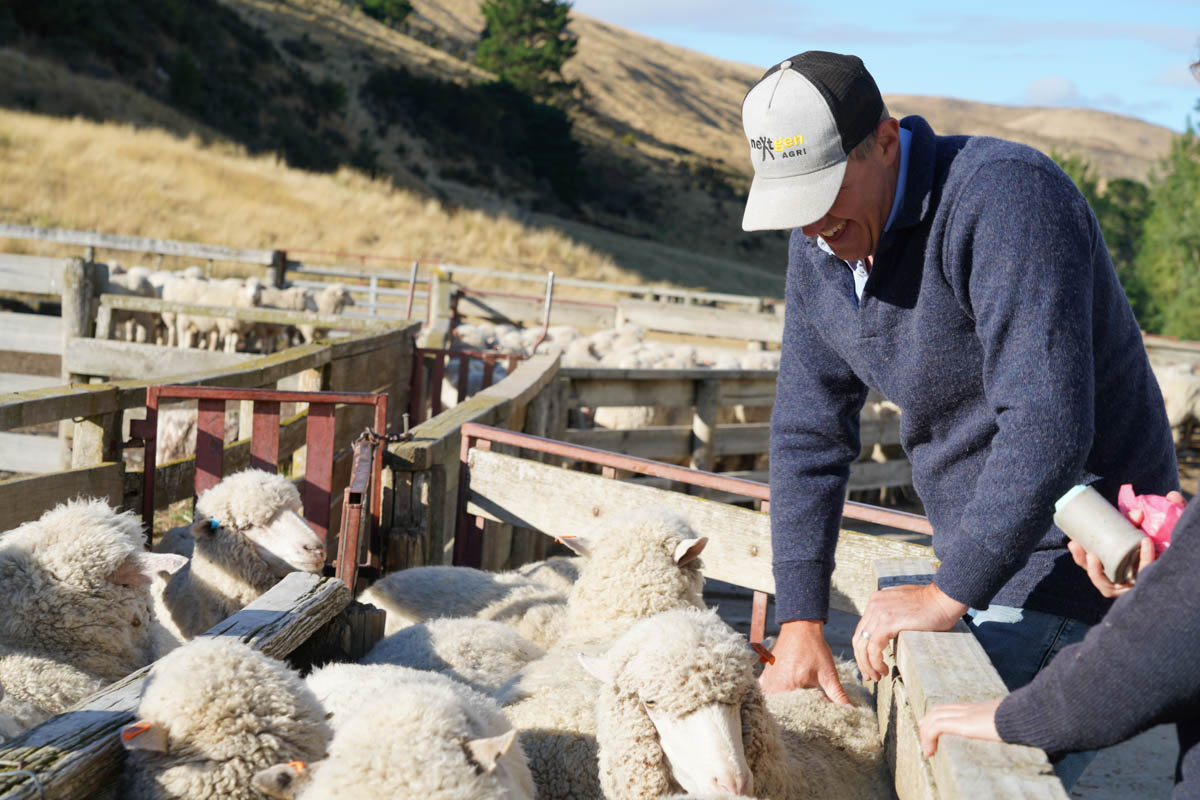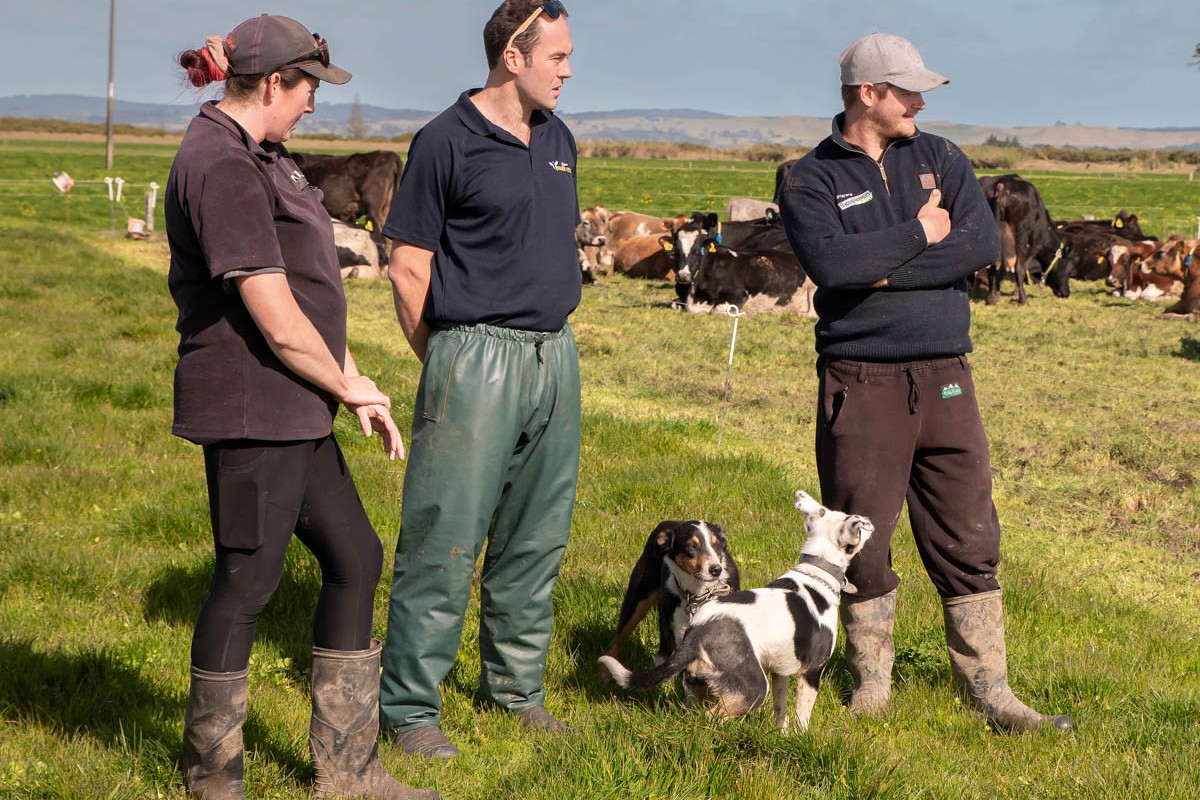Mike Bland reports on a farmer rejuvenating his bull beef business by benchmarking and focusing on production per hectare.
Matt Buckley’s participation in a farmer group dedicated to benchmarking led to a major shift in how he and wife Olivia run their bull beef operation.
Gone are the days when the King Country business would try to pump out bulls at the heaviest weights possible. Now the focus is on wintering lighter bulls at a higher liveweight per hectare, feeding them well, and finishing them at lighter weights.
The Buckleys have also changed the timing of bull purchases from spring to autumn and lifted winter liveweight by over 30%.
Matt Buckley says benchmarking has given them the confidence to make big changes “because now we are driven by the numbers”.
He says the new focus on per hectare production rather than per head will put the business on track to achieve a target of 400kg/ha of net product (meat and wool) by 2021-22.
This year he expects production to reach 345kg/ha – a big lift on the 260kg net product/ha generated in previous years. For the 2020-21 season he is forecasting another 25-30kg/ha lift as the benefits of capital fertiliser, increased subdivision, and the change in buying policy continue to accrue.
Matt and Olivia own the company Eight Mile Farms, a 2500ha (effective) operation that spans four farms in the Waitomo district – 620ha Waipa, 580ha Rangitoto, 480ha Waihanga, and 820ha Spring Valley.
Olivia works off-farm as a vet for four days a week but plays a significant role in the farm’s animal health programme.
“She’s also very good with the ‘people’ side of the business, so she handles much of the health and safety and employment work too,” Matt says.
He oversees the operation from home base at Spring Valley, situated at the Eight Mile Junction, south of Te Kuiti. About half of Spring Valley has been converted into a dairy unit that milks 770 cows at the peak. Sheep, beef cattle, and dairy heifers are run on the remaining 400ha.
A manager is employed to run the dairy unit, and two stock managers look after three of the sheep and beef blocks – Steve Knight on Waipa and Nigel Bird on the Rangitoto and Waihanga farms.
General shepherd Mark George assists on Rangitoto and Waihanga, and the Buckleys recently employed Robbie Duffin to help Matt with stock management on Spring Valley.
Each of the sheep and beef blocks winter a set number of stock. After winter, stock can be transferred from block to block if necessary. The bulk of the contour on the four properties is flat to rolling and the balance is medium hill.
Spring Valley was originally settled by Matt’s grandparents who bought 316ha in 1954. Matt’s parents Rob and Marg expanded the farming operation and Matt and Olivia managed the farm in partnership with them from the early 2000s. They recently purchased the business from Rob and Marg who have retired to a small block on the outskirts of Te Kuiti.
Pushing the bull beef system
Eight Mile Farms finishes 1600 30-month bulls and 250 steers annually, and it’s this side of the business that has undergone the most radical change in recent years.
Matt says rejuvenating the bull beef business gave him the challenge he was looking for.
“Since buying out Mum and Dad we’d been doing a lot of thinking about consolidation and how we could push our existing operation harder. We’ve got very good stock managers on board and that put us in a position to make some big changes to our system.”
Encouraged by Olivia and Rob, Matt participated in a Rabobank business development course in Australia about five years ago, which gave him “a lot of good ideas”.
“It taught me that I needed to lift my head up from the day-to-day running of the farm and focus more on the business as a whole. Farmers rely on the international market, so we have little control over the price we receive for our product. Instead we’ve got to take charge of the things we can influence.”
But it was the AgFirst Red Meat Profit Partnership (RMPP) Action Group that provided the impetus to transform the bull beef system. Facilitated by AgFirst consultant Steven Howarth, the King Country group was formed three years ago with a focus on benchmarking using Farmax.
Matt says his experience with the group, which includes members representing nine farm businesses, has been profound.
He enjoys the way members freely share information and bounce ideas off each other.
And Farmax has become a powerful tool for his business. All aspects of the operation, including pasture growth, soil fertility, and animal liveweight, are monitored and recorded in the programme.
“The more you put into it, the more you get out.”
Based on information provided by the group and Farmax, changes made to the bull beef system include capital fertiliser applications, increased subdivision, and an extended winter round length.
Bulls are farmed on about 800ha across the four farms, and the bull country is permanently fenced into 1.5 to 2.0ha paddocks. Temporary fencing has been used to subdivide the bull blocks further.
“Thousands upon thousands of polyrods” have been used to cut these paddocks into four for winter grazing.
Traditionally, about 25units/ha of Phosphate have been applied to maintain P levels but this has been lifted to 40units/ha. With around 1200 tonnes of fertiliser applied annually over the last two years, Olsen P levels are expected to reach 30-33 on the bull country.
Increased fertiliser application and extra subdivision has enabled the winter grazing round to be extended from 60 days up to 80-90 days. Winter stocking rates have also increased.
“On some of the better country we have increased our wintering liveweight/ha from 750kg to 1000kg. So we are carrying more lighter-weight bulls and that gives us the mouths we need to utilise the spring flush.”
Matt says winter liveweight could potentially increase to 1200kg/ha in future.
Finishing weights and killing dates have also changed. Thirty-month bulls that were killed at 360-380kg carcaseweight (CW) are now finished at 320-350kg CW.
“Instead of sending them off between November and the end of January they now go mid-December to late February.”
Nitrogen is used to boost pasture covers at crucial times with about 28-30units/ha applied in Spring and Autumn.
Matt says the aim is to get pre-winter pasture cover up to 3500kg DM/ha by May 1. Paddocks with 30-month bulls are grazed to a residual of 1200-1300kg DM, and the 20-month bulls, which are wintered at about 800kg LW/ha, come out at around 1500kg DM/ha.
By late October pasture growth rates can be hitting 45-50kg/ha/day, so the extra bulls are crucial for pasture control.
“The goal is to match the bull unit’s feed demand with pasture growth rates in spring.”
As a result of changes to their buying policy the Buckleys are no longer dependent on spring livestock markets.
R2 bulls are now purchased at around 400kg in autumn. About 250 bull calves are supplied by the dairy unit on Spring Valley and the rest of the mainly Friesian bulls come from anywhere in the North Island.
“Two years ago we were buying about 85% of our bulls in spring,” says Matt.
“Last year we didn’t buy one. Now we buy when we need to and not when we have to.”
Buying bulls in autumn is a significant advantage.
“It means we can buy bulls to fit our pre-grazing winter covers. We are now in charge of when we buy our stock and we can do it to fit the farm’s pasture supply curve. If we had been buying bulls in spring this season we would have been caught out badly by this year’s drought.”
Traditionally, R2 bulls were wintered in mobs of about 70 but this was reduced to 55-60 last season.
Matt says mob size can be a “contentious” topic for bull farmers and he gets a few raised eyebrows when he mentions his.
“A lot of people will say that mob size should be about 20-30 right throughout but I haven’t seen any evidence to suggest that a smaller mob means more production out the gate.”
While a bigger mob can mean more niggle, Matt says a significant advantage of the larger mob size is a lower labour requirement and cost.
“If we were running smaller mobs in winter we would need an extra labour unit.”
Mob size is scaled back to 25-30 in late August/early September.
Sheep could be the next focus
Along with bulls, steers and heifers, Eight Mile Farms also winters about 5000 Kelso ewes and 1500 hoggets.
Matt says high-performance sheep are an integral part of the operation. Mixed-aged ewes pregnancy scan at over 180% (triplets not scanned) and dock at around 145%, with most lambs finished at 17-17.5kg CW by late March.
“The plan is to finish all lambs but we don’t always achieve that. Last year we had to sell about 10% store.”
Matt says ewes generate a return of about 18-19c/kg DM. While this is less than the bulls he says it doesn’t take into account the value of sheep as a grazing management tool on the tougher contour.
“It’s all about matching stock class to the land type. The sheep have to perform, and they do.”
Once the bull beef unit is firing on all cylinders, Matt says the next logical step would be to take a good look at the sheep system “and see if we can push that a bit harder too.”
He says the changes made over the last two years have been exciting.
“It’s given me the biggest challenge since I started farming in the mid-1990s. It’s great to partner with key staff and other support people who want to move forward with you.”
If the 400kg/ha of net product is achieved it will push the business into the top quartile for production when compared with farms of similar class.
“But that’s not really what it’s about. The goal is to achieve a balance between production and making sure our people and our stock are well looked after.”
ONCE-BRED HEIFERS ON THE RISE
This year the operation will also kill 60 heifers, with plans to increase this to 200 next season.
“We are moving into once-bred heifers because their production in relation to drymatter consumption is very attractive,” Matt says.
He estimates once-bred heifers will produce a return of 15-18c/kg DM consumed, while the bulls generate 20-21c/kg DM. The steers, which are often run with the ewes and used for pasture control, contribute about 10-13c/kg DM.




